Displaying items by tag: Peter Malone's Movie Reviews
Pedro Paramo
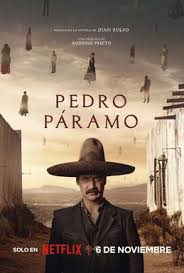
PEDRO PARAMO
Mexico, 2024, 130 minutes, Colour.
Manuel Garcia-Rulfo, Tenoch Huerta, Dolores Heredia, Ilse Salas, Mayra Batalla, Roberto Sosa.
Directed by Rodrigo Prieto.
Background: in this Mexican film is based on the celebrated novel, published in 1955, by Juan Rulfo. It is credited with offering cultural and religious background in Mexican history and, in the literary world, introducing the style of “magic realism”. While it has an introductory narrative, the novel and the film moves between the real world and an imaginary world, spirits, ghostly presences, there are flashbacks to an actual past combined with the consequences in the real world and in the spirit world. There is a Catholic background, represented by an obsessive priest, but also pre-Christian beliefs about death, heaven and hell, the after-world, of the spirits of the dead roaming the world.
This film version was written by Spanish writer, Matteo Gil. It has been directed by cinematographer, Rodrigo Prieto, his first feature film, a favoured cinematographer by Mexican directors as well as for several films by Martin Scorsese – and Barbie!
Here, the cinematography is evocative, vast arid Mexican plains, the remains of the ghost city, vibrant and colourful flashbacks of life when the city prospered, and many dark sequences, strange presences, death experiences, ghostly communications.
The film opens with a man coming to the town where he was born, at the behest of his mother, to meet his father, make claims from him, understand him. However, his father is dead. And, in the town, many strange characters, women who had encountered his father, his father’s devoted housekeeper, some of his father’s wives and women. And the question is whether the man himself, with his experience in the town, is now dead and is part of this unearthly community.
The book and the film provide many challenges to readers and viewers, to identify the particular characters, especially the father, seeing him as a very young man, middle-aged, older, finding their place in the town, in relationships.
The time setting th ranges from the end of e 19th-century, era of wealthy landowners, patriarchy, exploitative of women, ignoring children, arrogant presuppositions of superiority to the Mexican revolutions of the 1910s. And the role of the church, religious traditions, funerals, confessions, and strange theological expressions.
The film was well received, comparisons naturally made with the novel, but the film is an interpretation of the novel and they are not to be equated.
- The original novel, its worlds, the real world, the spirit world, the history of Mexico, the late 19th century, early 20th century, patriarchy, exploitation, the revolutions of the 1910s?
- The adaptation of the novel, structure, characters, its variety of worlds, and novel texts and speeches becoming part of the screenplay?
- The landscapes, the opening, mountains plains, desert, the abandoned town, the wrecked buildings, the dark streets? The dark atmosphere, characters appearing and disappearing? Juan and his journey, whether he was dead or alive?
- The contrast between the ghostly abandoned town and the flashbacks, prosperity, farms, the landowner, the workers, the foreman?
- Pedro, the title, talk about him, audience attitudes, Juan’s mother and her leaving, the encounter with the man, his being one of Pedro’s sons (and his later appearance to plead for money for the burial of h and is wife and his being rejected, killed)?
- The role of women in the film, the dead mother and her history, the marriage, her period and suggesting her friend substitute for her with the husband, her pregnancy, the birth, departure? Susanna, as a girl, flirtatious with Pedro, her having to leave, looking back, her later return, the black-and-white pool sequences, the relationship, her illness, Pedro and his attentions? The role of the priest and his interventions, especially as she was dying, the experience of her death? The mother’s friend, still in the town, offering hospitality to Juan, her stories, especially about his mother? Her disappearance?
- Damiana, her appearance, guiding Juan, the flashbacks, the significance of her role in the household, housekeeping, advice, with Pedro, with the other women, serving them? Her influence on Juan?
- The woman in black, hunched, observing, on the outer, needing food, her interventions, her guiding Juan? The forceful character?
- The presence of the priest, his attitudes, the deaths of his relatives, the blaming of Pedro, the funeral of the son, his initial refusal to pray, the sprinkling of the holy water? His utterances, theological, life and death? The confession sequences? His continued presence, rituals, his presence at Susanna’s death, the weirdness of his prayer, incorporating traditions and superstitions, earth and the mouth, the nature of sin and corruption, possibilities of forgiveness or not, hell and heaven? The revolutionaries, arrival, Motley again, threats to Pedro, the table, checking the leaders, offering the money, the bargain, the consequences?
- The portrait of Pedro, as a wilful young man, his wealth, his father, the women, the story of his son, his son and his exploitative behaviour, his death, the funeral? His foreman and the work, on the property, the workers? His prosperity, the socials, his wives, his behaviour, Susanna’s return and its effect on him? The visit of the revolutionaries, his sitting with them, offering his help, the foreman, the killing him and leaving him in the flowing water?
- Time passing, changing Mexican society, the challenge to the patriarchy and the landowners, Pedro and the death of Susana, his grief, his sitting in the chair, growing older? The final challenge, the attack on him, on Damiana, their deaths?
- The impact of this film for Mexican audiences and their knowledge of the novel? On Spanish-speaking audiences? On world audiences and their being invited into this very different world?
Martha
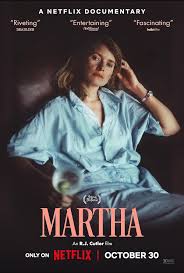
MARTHA
US, 2024, 115 minutes, Colour.
Martha Stewart.
Directed by RJ Cutler.
In the later decades of the 20th century, most Americans knew the name, Martha Stewart. She had become a significant “influencer”. Not so well-known outside the United States, but influential with her range of magazines and her company, the focus on “Living” and how best this could be done in the US context are American women and home keepers, especially in the changing feminist perspectives of the 20th century.
For non-Americans, there was a general awareness of Martha Stewart and her high profile. So, it was something of a shock when in 2004 she was in court, sentenced to prison and serving her sentence.
This documentary, well written and directed by RJ Cutler (many documentaries, especially an insightful portrait of comedian and actor, John Belushi), offers us a portrait and study of Martha Stewart. Because of her high-profile, there is a great deal of newsreel footage over the decades, and especially her television presence and her shows. No lack of photo material. No lack of people able to comment.
But, the major advantage is a long interview with Martha Stewart herself (the later 70s) which forms the core of the documentary, Martha Stewart in her own words, and the audience able to look at her, listen to her, note her reactions, note the body language, hear the intonations. She herself made some objections about the documentary itself and what was included and what was excluded. (Not favourable to her final aged image very happy with the first half of the film.)
There is the expected material about her childhood, comfortable in New Jersey, intelligent and smart, modelling, commercials, in the mid and late teens, her being an enterprising young woman, her marriage, studies, pregnancy and child, but her being strong-willed and determined.
For audiences who want more background to Martha Stewart, the Wikipedia article is quite extensive and detailed.
With Martha Stewart herself giving the commentary as well as all the media that can be drawn on, the audience sees her career as a stockbroker on Wall Street, her moving into the catering business, being a shrewd businesswoman, many saying she was very difficult to work with, developing all kinds of advice for American women and their households, cooking to gardening, her move into writing, the link with the Time company, books and range of magazines. By 2000 her company, Omniliving, went public, Martha Stewart the billionaire.
For those familiar with the charges of insider trading, this documentary spends a lot of time with explanations of Martha Stewart’s friendships and connections, developments of drugs and medication, deals, collapses, her decisions about selling stock, the charges. And, there is a great deal about the trial itself, her reaction, her presence, sentence.
While she was imprisoned for five months,, finding it difficult, she nonetheless survived and made the most of it. And, in the coming years, sometimes retiring from public view, she recovered, emerged, the documentary spending a lot of time on her role at a Roast for Justin Bieber, her taking over, her humour, her relating to the younger generation, the connection with Snoop Dog at the Roast and then teaming with him for a television show, showing that in her 70s, she was not prepared to look back and that you connect with the younger generation!
So, RJ Cutler presents this portrait of Martha Stewart, very much in her own words, very much in the images of her, the American dream of success, her fall but, nevertheless, recovery.
(A very good insight is provided by film reviewer, Owen Gleibman Variety: marketing the Martha personality: the self-empowered WASP goddess, direct and imperious, with an eerily serene grin of beatific power. She was a woman who glowed, who peered at the world through an upscale glaze. Those familiar with Carl Jung and personality types, and the Myers Briggs Type Indicator, Martha Stewart could be a powerful example of the Type, ENTJ, the type shared, it is suggested, by Margaret Thatcher, Pope John Paul II, D Roosevelt, Steve Jobs…)
Mary/ 2024
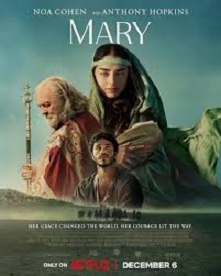
MARY
US/UK, 2024, 112 minutes, Colour.
Noa Cohen, Anthony Hopkins, Ido Tako, Hilla Vidor, Ori :Pfeffer, Gudmunmdur Thorvaldsson, Mila Harris, Dudley O'Shaughnessy, Eamon Farren.
Directed by D.J. Caruso.
Almost immediately, Mary looks straight to camera telling us to trust her, that we do not know her story at all. And, by the end of the film, we realise that, apart from the key Gospel scenes of the infancy narratives, just how much inventiveness there is in this storytelling. It is the work of screenwriter, Timothy Michael Hayes who is credited in the Internet Movie Database note, as responsible for “inventive biopics”. This is certainly the case here (and we might agree with the familiar declaration during the final credits that, while based on actual characters, characters and events have been reworked for dramatic purposes.
It was only in the second and third centuries that Christians wanted to know more about the biblical characters, creating alternative narratives, different Gospels, giving names to characters who are not even mentioned in the Gospels, especially Mary’s parents, Joachim and Anne. The screenwriter has drawn on some of these apocryphal Gospels, especially the proto-evangelion of James, as well as the visions of mystics like Maria of Agreda and Anne Catherine Emmerich, the latter one of the inspirations for Mel Gibson’s The Passion of the Christ.
With the focus on the young Mary, her elderly parents praying for a child, their dedicating her to the temple, Mary as a young student at the temple, the encounter with Joseph…the film might well be described as a Young Adult interpretation of Mary aimed at the young adult audience. But, while the film might have been open to younger children’s audiences but the Mary stories interwoven with the dramatic history of Herod the Great, played by Anthony Hopkins in his mid-80s like a King Lear gone wrong, with some very bloodthirsty sequences, his torture of the High Priest, and the expected massacre of the innocents.
Filmed in Morocco, one of the difficulties is that the film’s sense of geography, Nazareth in Galilee, Jerusalem in the south, Bethlehem near Jerusalem, is rather skewiff, especially the closeness here of Nazareth to Jerusalem.
The screenplay also draws on some familiar Gospel themes and applying them these characters, Joachim fasting for 40 days and 40 nights in the desert, the visitation with Mary and Elizabeth, Mary under suspicion for her pregnancy and the possibility for her being stoned…
One of the difficulties of the screenplay is the frequent appearance of Gabriel, always in blue, sinister rather than angelic and also Satan with taunts and temptations for Mary. Which means then that Mary as the mother of the Messiah seems to be fairly common knowledge not only for her family, but for the high priest, for Herod, and for the people, the knowledge of the bright star signalling Jesus birth. Not exactly the Gospel perspective on the gradual awareness of Jesus and his mission.
One Gospel character does get some welcome attention, the prophetess Anna in the Temple, friend and protector of Mary (a credible and welcome interpretation of her role), with a frail Simeon coming in with his words to Mary of the sword piercing her heart.
There will be a variety of responses to this film, biblical scholars probably not enthusiastic at all, ordinary viewers, not familiar with Gospel details and literary forms, enjoying it at the Young Adult level mixed with swords and sandals atmosphere.
An American priest, from Green Bay diocese, Edward Looney, a theologian with an emphasis on Marian studies, was invited to write almost immediately an analysis of the screenplay for Crisis Magazine, relating it to the Gospels, and noting the influences of the early alternate Gospels and the visions of the mystics. It is well worth Googling: https://crisismagazine.com/opinion/the-unrecognizable-netflix-mary
- The traditional Gospel films, biblical epics, Mary stories?
- A film for the 21st-century, imagination about Mary, the re-creation of her early life?
- The Gospel references, comparatively few, the drawing on second century apocryphal Gospels and their narratives, the naming of characters unnamed in the Gospels, Joachim and Anne? The Gospel-referenced Simeon and Anna, the attention given to the prophetess, Anna? The influence of the German mystics, Spanish and Italian mystics and their visions?
- The screenplay, the young Mary, the young Joseph – and the tone of a Young Adult story? The language of coming-of-age?
- The visuals, the recreation of Jerusalem, Bethlehem, the surrounding desert? The placing of Nazareth nearer to Jerusalem than it is? The musical score?
- Audiences watching the film, biblical scholars reacting to the license taken with the storytelling and imagination, the Catholic and Christian audience and their knowledge of Mary, interest in the imaginings? Non-Catholics and members of other religions, or not, observing it as a narrative?
- The setting, Joachim and Anne, his 40 days in the desert, her pregnancy, giving birth, committing Mary to the temple, their life in Nazareth, Joachim under attack? The concern for Mary, the meeting with Joseph, the betrothal, her pregnancy, the law and her possibly being stoned?
- The appearances of the Angel Gabriel, the blue cloak, the somewhat sinister androgynous look? Appearing to so many people, the screenplay indicating that most people knew that Mary was chosen, the birth of her son, his mission? The appearances of the Satan, his confrontation with Mary?
- Mary, the temple, with the other young women, her concern about the poor, charity? With the authorities? Reprimanded? With Anna? The washing, the encounter with Joseph?
- Joseph, young, his friends, the discussions, not particularly interested, fascinated with Mary, his approach to her parents, the courtship, the betrothal, her situation (and his not being warned in a dream to take her), the journey to Bethlehem, the crowds, the inn, the birth?
- The other half of the film with Herod, Anthony Hopkins as a demented monarch, his relationships, wife, executions, his family? The rebuilding of the temple? His military advisor? His status, his image of himself? The tantrums? Visit to the temple, confrontation with Mary? The news about the child, the visit of the Magi, the attack on the children of Bethlehem, the killings, the rounding up of the babies, the corridor with the cribs? His vision of himself, in relationship to Rome and the Empire?
- Mary and Joseph going to the temple, the presentation of Jesus, Simeon and his prophecy?
- A satisfying drama, dramatising biblical stories, the inventions, the 21st-century perspective of storytelling?
Hot Frosty
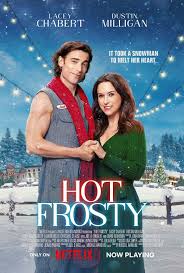
HOT FROSTY
Canada/US, 2024, 93 minutes, Colour.
Lacey Chabert, Dustin Milligan, Craig Robinson, Joe Lo Truglio, Katie Mixon Greer, Lauren Holly.
Directed by Jerry Ciccoritti.
Hot Frosty, a Netflix Christmas movie amongst many others, was described as “affable”. And, for most audiences, it is.
It is a variation on the Jack Frost story, Jack Frost coming alive and joining a community for Christmas. Over many years, Lacey Chabert has been a popular star of television films, over 30 for Hallmark. Here she is again, Kathy, a grieving widow, managing a cafe, many friends in the small town, but letting her life and repairs on her house slide.
She is given a red scarf by her friends at a store, wraps it around a snowman in the centre of town where there is a display of sculptured snowmen. And she takes a photo of him. And, he comes alive, a touch embarrassed with no clothes, scaring an elderly couple, falling backwards through the window of the store, getting some clothes, one with the label, Jack. He is continually cold and tries to avoid, sometimes unsuccessfully, anything which might heat him up.
As expected, he is charming, very agreeable in conversation, no memories before Kathy and the scarf, but, as the film progresses, he is able to pick up all kinds of information from watching television programs, becomes a handyman par excellence, and, shirtless, attract a lot of attention from the rather middle-aged ladies of the town. He also helps out one of their sons, the school principal, helping with repairs at school, working with the kids, absolutely charming.
On the other hand, the by-the-book and beyond sheriff of the town, played by veteran Craig Robinson, quotes the law all the time applied rigidly, and is determined to arrest the vagrant who scared the elderly couple and who smashed the window of the store and stole the clothes. He assisted by a very genial comedian, Joe Lo Truglioi, as his more sympathetic Deputy.
Kathy resists the romance, Jack relies on her and fixes the house. And he invites her to the school dance. And, of course, the sheriff arrests Jack, the doctor stating that he is a snowman, and the townspeople making an appeal. And, eventually, Jack and Kathy kiss. Jack had seen a promotion for Hawaii, not realising it was hot, but, as he seemed to come alive as human, he had Kathy buy a ticket for Hawaii.
A cheerful and light variation on the theme.
Road to Morocco, The

THE ROAD TO MOROCCO
US, 1942, 82 minutes, Black-and-white.
Bing Crosby, Bob Hope, Dorothy Lamour, Anthony Quinn, Dona Drake.
Directed by David Butler.
This is the third of the Road to… Movies starring Bing Crosby, Bob Hope and Dorothy Lamour. The films were very popular in the 1940s, most of them released during the war.
All popular at the time, in retrospect they seem rather silly. Although, a good word to describe them is “zany”. By this third film, there are all kinds of in references to Paramount Studios, to Dorothy Lamour surely turning up, audiences coming late into the film and missing Bing Crosby’s song… And, Bob Hope, always enjoyable, doing a lot of ad-libbing and eyebrow raising.
This time they are two friends stranded at sea when the ship blows up (Bob Hope smoking in the powder room). There is discussion about Bing Crosby eating Bob Hope to survive if they are at sea for a long time. However, they land in the desert, licked by two camels (and the spitting scene was actual rather than rehearsed), riding into a town, a lot of mixups, Bob Hope pretending to be mentally limited because locals were honoured (definitely not politically correct these sequences). Then, Bing, always smooth, trying to get the upper hand, sells at Bob who finishes up in a palace luxurious style. And the Princess’s Dorothy Lamour.
So, a whole lot of contrivances for slapstick comedy, mistaken identities, the tough swashbuckling locals, led by Anthony Quinn, doublecrossing romance, and the final disruption of the wedding ceremony by the two with all kinds of silly tricks. Dona Drake appears as the maid sympathetic to Bob Hope.
And, at the end, they all stranded – but off the coast of New York, Bob declaiming about being lost at sea, the Statue of Liberty being pointed out and his own comment that is missing was cut and he might have had an Oscar nomination!
Bing and Dorothy Lamour both sing Moonlight Becomes You. But, the famous song is We’re off on the Road to Morocco – and the famous line “like Websters Dictionary, we are Morocco-bound”. However, there were two further variations on Morocco-bound:
We may run into villains but we're not afraid to roam
Because we read the story and we end up safe at home (yeah)
Certainly do get around
Like Webster's Dictionary we're Morocco bound
We certainly do get around
Like a complete set of Shakespeare that you get
In the corner drugstore for a dollar ninety-eight
We're Morocco bound
Or, like a volume of Omar Khayyam that you buy in the
Department store at Christmas time for your cousin Julia
We're Morocco bound
Monkey Business/ 1931

MONKEY BUSINESS
US, 1931, 77 minutes, Black-and-white.
Groucho Marx, Harpo Marx, Chico Marx, Zappo Marx, Rockliffe Fellowes, Harry Woods, Thelma Todd, Ruth Hall, Tom Kennedy.
Directed by Norman Z. McLeod.
Monkey Business is the third of the Marx Bros comedies at Paramount in the early 1930s. It was the first written for the screen and filmed in Hollywood (the earlier two at Paramount Studios in New York)
The setting is a transatlantic liner, the brothers stowing away in barrels, heard singing, exposed, then chases all around the ship throughout the film, tantalising the captain, usurping his authority, tormenting his assistant. The film gives the opportunity for the Marx Bros to establish their screen personas, developing them from their theatre performances, Groucho and his moustache, eyebrows, stooped walk, wisecracks, cigar, twisting the plot to his own advantage. Chico does some comedy but, finally, shows his versatility at the piano. Harpo, in the early films, chasing the women (almost, indeed, harassment), not talking, but finally getting the opportunity to attend of the film to play the harp. The Zeppo is the straight man, involved romantically with the daughter of a gangster on the ship.
There is a lot of comedy with the gangsters, Chico and Harpo hired as hitmen, Groucho twisting loyalties, and the femme fatale, wife of the gangster, Thelma Todd, who wants more out of life and has some innuendo sequences and lines with Groucho.
The film is well remembered but, audiences coming to this film in the light of the later films at MGM, it looks like a promo for their careers and is more than a bit silly!
Our Little Secret
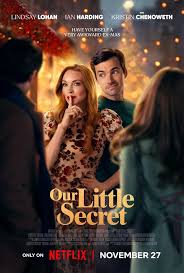
OUR LITTLE SECRET
US, 2024, 101 minutes, Colour.
Lindsay Lohan, Ian Harding, Kristin Chenoweth, John Rudnitsky, Katie Baker, Jack Brennan, Tim Meadows, Judy Reyes, Henry Czerny
Directed by Stephen Herek.
One of several 2024 Christmas films screened on Netflix. It is a star vehicle for Lindsay Lohan, following her Irish adventure, Irish Wish.
The film opens, with some animation sequences, indicating the two central characters, Avery, Lohan, and Logan, Ian Harding. She is ambitious in her work, he wanting to propose,her refusing and going to London… And some more animated indications of 10 years passing.
In 2024, Avery is dating Cameron and going home to meet his parents for Christmas. In the meantime, Logan is almost engaged to Cameron’s sister. When they unexpectedly meet, they decide to keep their past relationship secret. Which, of course, leads to all kinds of embarrassing situations, semi-revelations, cover-ups.
But, the most arresting characters in the film is the dominating mother played by Kristin Chenoweth, controlling the household, eccentric manner and speaking, demanding how Christmas should go.
In terms of secrets, there is a revelation that there are all kinds of secret relationships and the guests for Christmas, even Kristin Chenoweth knowing her husband’s affair but carrying on regardless. And she is dominating to her two children. Cameron meeting a friend from the past and… Inevitably…
Audiences may enjoy some farcical situations, Avery eating the special biscuits, blaming the dog, taking it to the vet as a cover, conniving with the vet, eventual revelations. However, the annoying character is the younger brother who spies on everything, demands bribes for cover-ups.
Eventually, revelations, Avery’s father coming to visit (and unexpected genial term from Henry Czerny), great job opportunities for Logan and a romantic ending.
Another Christmas film for those who love the genre to add to their accumulation.
Moana 2
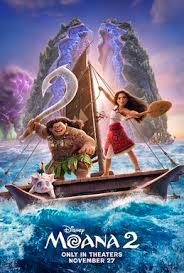
MOANA 2
US, 2024, 100 minutes, Colour.
Voices of: Auli'i Cravalho, Dwayne Johnson, Chung, Rose Matafeo, David Fane, Awhimao Fraser, Temuera Morrison, Rachel House, Alan Tudyk.
Directed by David G. Derrick Jr, Jason Hand, Dana Ledoux Miller.
It is a surprise to find that the first Moana film was released in 2016, 8 years ago. There had been an intention to do a sequel as a television series in 2020 but that did not happen. Instead, here we are in 2024, meeting the characters again, travelling back thousands of years, to the islands of the Pacific, to the Polynesian inhabitants so long ago.
But audiences who were enthusiastic about the first film, and they certainly were, now have an opportunity to meet the characters again, the intrepid Moana (Auli'i Cravalho playing Moana again), the companion pig and chicken (although this reviewer had very low tolerance for the chicken as a character, rather annoying, caught in all kinds of silly situations – but that is a comment from an older viewer, while the youngsters will probably want more!).
In many ways, this is a repetition in story of the first film. We see Moana’s community, the chief her father, her great reputation she had achieved as a sailor and “Wayfinder”. But, the community is isolated, not sure where there are more people, more islands in the ocean. As in the first film, there is the heroic Maui (voiced by Dwayne Johnson) who has been a live for thousands of years, his body covered in tatters which come alive to tell the story of his adventures. He comes to join Moana and another group of sailors, a young man who idolises Maui and very feisty young woman and old grandfather, cantankerous, and the pig and the chicken!
So, lots of sea adventures. A visit to an island of coconuts who have a life and language of their own, seem hostile but are friendly, contribute to the expedition across the seas. There are all kinds of creatures in the sea, even waves of the ocean coming alive, and, as the crisis mounts, vengeful deities, a strange malevolent queen who has the power to destroy the wayfarers, and ever-increasing storms which take their toll on the expedition.
But, in the spirit of the traditions of the Polynesians, their seafaring, their settling of the islands around the Pacific, there is the revelation that they are not isolated, that there is great joy in finding other communities and uniting with them. (And, the alert audiences will hear many New Zealand accents, Rachel House, Temuera Morrison, Jemaine Clement, who appears in the mid-final credits sequence, jokey, but those who instantly make a beeline for the exit as words appear on the screen at the end, will miss it.)
So, a variation on the Disney princess, the Polynesian Princess, Moana, colourful action, intriguing characters, the importance of storytelling, images, not only in caves but on the tattoos of the characters, bringing those stories to life. And, this time there are some jolly songs, pleasant interludes, tunes and lyrics that are easily accessible, especially to the younger audience. And, indeed, Moana is a film for the younger audience, very strong, of course, for the young girls who will enjoy it.
- The popularity of the original film? Television series not eventuating? The happy reception of this sequel?
- Disney style, the animation, the drawing of the characters, their interactions, humans, animals, fantasy creatures, locations, the sea, islands, the coconuts…? The musical score, the role of the songs, the chirpy lyrics, the tunes?
- Intended audience, the youngsters, younger girls, the adventure tale of a Princess who is not actually a Princess?
- The establishing of Moana as character, her quest in the first film, the Wayfinder, her achievement, the relationship with Maui, with her family? Wanting communication with others in the ocean? The initial venture, the storm, her achievement, return home? The reception, the celebrations on the island, her father, mother, the family?
- The introduction of the familiar characters, Maui, the demigod, collaboration previously with his return, the interactions, the banter, travelling with her again?
- The pig, friendly, cuddly? The chicken, fiascoes, comic, irritating?
- The new quest, her companions on the journey, Lote as a vigorous young female, Moni, young, enthusiastic, his admiration for Maui? Kele, the cantankerous father? Leave, help, collaboration marijuana
- The visualising of the voyage, the sea, the waves, the oceans, the arrival at the coconuts island, the interactions, the help, the coconut guiding them? Maui and his advice, interactions with minor?
- The vast island, the split, separated, the adventures, the dangers, surviving?
- The quest to confront the angry God, to discover more humans?
- Matangi, under the spell of the God, her life, machinations, her song, decision to help, confronting the God?
- The achievement, the discoveries, the return home, the welcome? Moana as a true Wayfinder?
Fiore Gemello/ Twin Flower
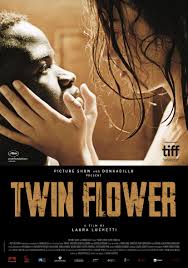
TWIN FLOWER/ FIORE GEMELLO
Italy, 2018, 96 minutes, Colour.
Anastasiya Bogach, Kallil Kone.
Directed by Laura Luchetti.
Twin Flower is a small film from Italy, a focus on two young characters, their backgrounds, meeting, interactions, mutual protection.
The initial focus is on Bsim, from Ivory Coast, trying to help people at supermarkets with their trolleys but ousted by the manager, going on the road, recent migrant, no papers. The next focus is on Anna, running away from a man in pursuit who has been wounded. Her story is not explained until flashbacks later in the film, her relationship with her father, their bonding, his being involved in refugee trafficking, and his being killed by his partner, in defence of his daughter.
Basim is very sympathetic. Anna that is traumatised and does not speak. They travel together, gradually supporting each other, she employed by a sympathetic arranger of flowers, Basim revealed as being the object of sexual encounters in the town. But he finds a place where they both can live.
The audience is invited to empathise with the two characters, the traumas from the past, their coming alive in this encounter with each other, surviving dangers when Anna is pursued by her father’s killer, defended by Basim, and continuing on the road together.
The film is very sympathetic, a female perspective by writer-director, Laura Luchetti,
- The title? The work with the flowers and arrangements? The image of the flowers, and discovering the flowers, putting them in a vase?
- The setting, Italy, the South, ordinary life, supermarkets, flower arrangements shops, stalls, landscapes, industry, the fields and forests? The musical score?
- Basim, from Ivory Coast, his age, no papers, trying to help at the supermarket, being ousted, on the Road, being picked up and offered the meal, the encounter with Anna, her not talking, the sharing food with him, the continuing together, getting the job, Basim refused, his night wanderings, the sexual encounter and the repercussions, in the bath, the encounter with Anna, accosted by the man and his refusal, the sympathetic androgynous man, protecting Anna, the assailant, his saving Anna?
- Anna, running from the man, his wound, her not talking, on the road, the encounter with Basim, giving him some food, his leaving, her following, sharing the road, her getting the job, enjoying arranging the flowers, the sympathetic owner and his support, the flashbacks, her father and the happy times, his death, the pursuit by the killer, his intentions with her, in the vehicle? The bonding with Basim, the sexual encounter, her packing, the pursuit of the killer, saved by best seem?
- The killer, people smuggling, his eye on Anna, the confrontation with her father, the killing? His pursuit, the drive, interrogating the flower arranger, the confrontation, the violence, Basim rescuing Anna?
- The couple walking on together? To what future?
In Her Place/ El Lugar de la Otra
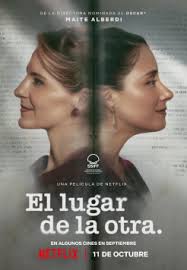
IN HER PLACE/ EL LUGA DE LA OTRA
Chile, 2024, and 89 minutes, Colour.
Elisa Zuleta, Francisca Lewin, Marcial Tagle, Pablo Macaya.
Directed by Maite Alberdi.
This crime and legal drama is based on actual characters and events, 1955, a writer killing her lover publicly in an exclusive hotel in Santiago.
It has been written and directed by Maite Alberdi, documentary filmmaker (Oscar-nominated for The Mole Agent).
However, the film focuses on a judge and his being appointed to interview all the witnesses as well as the accused, to make a judgement for a prison sentence, and the focus on his legal assistant, Mercedes, an intense performance by Elisa Zuleta. The film offers background to Mercedes’ character, her ordinary life, financial struggles, her husband a commercial photographer, two sons at home. However, working with the judge, her life is open to all kinds of interesting experiences, encounters, different ways of assisting the judge in his enquiries.
The meaning of the title becomes clearer when Mercedes is asked to look into the accused’s apartment, getting the key, becoming absorbed, infatuated, continually returning, wearing the accused’s wardrobe, her perfume, becoming more and more at home, even in an encounter with a previous lover of the accused who finds her in the apartment. She continually watches the accused, giving her cigarettes, and eventually sent to photograph the Good Shepherd institution where the accused is lodged.
Not only is Mercedes in her place in terms of psychological identification with the accused, but literally in her place, in the apartment.
Mercedes needs and wants a break from the noise at home, her snoring husband, her rowdy children, her talkative extended family, her husband eventually following her to the place and discovering her secret and what she wants.
Meanwhile, the author writes a book in her confinement, and it emerges that she was imitating an actual story 1941 about a previous England author, a similar killing, and her eventually being pardoned.
And, a final drama when one of Chile’s most eminent poets write a letter to the president and effects a pardon for the accused, Mercedes having to move out, watching the freed woman return to her apartment.
What we have watched the accused with great interest, most of our attention is on Mercedes and the intensity of her psychological behaviour.
- The title, Mercedes and her identification with the author, psychological and identification? But her literally moving into the apartment and living her life?
- The 1955 setting, society, the hotel, the women going inside and only on invitation, the situation, the author, shooting her lover, the blood on her face, escorted out, the media, shouting, photographed, extensive stories about her drinking the blood of her victim…?
- Mercedes, her character, at home, her snoring husband, getting up, breakfast, her sons, the confined living space, her husband and his customers, the photos, Mercedes welcoming the customers? The contrast with her going to work, in the legal office, with the judge, the team, the judge relying on her, her contributions to the investigation, typing, the judge and the interviews?
- The accused, the judge and his interrogations, her lack of collaboration? The issue of her being held, bail, prison, her going to the Good Shepherd institution, with the other prisoners, the nuns? Mercedes identifying with her, looking, judging her guilty, the cigarettes?
- Mercedes, going to the apartment, to get the clothes, looking in the mirror, identifying with the accused, her going back to the apartment, the wardrobe, the perfumes, reimagining the life there, her continued returning, literally in the place of the accused?
- The progress of the case, the lawyers, the witnesses, the brother of the murdered man, the sister of the killer, the different perspectives?
- Mercedes, typing, observing, going home, staying at the apartment, her husband’s concern, the big family gathering, her finding it oppressive, her husband following her, discovering, staying the night?
- Mercedes asked to photograph the Good Shepherd institution, her visit, the discussions with the accused, the range of photographs, the accommodation, herself?
- The final judgement, the sentence, 541 days?
- The poet, the appeal to the government, the granting of the pardon?
- The consequences for Mercedes, having to move out, watching the accused return home?
- The portrait of Mercedes, her ordinary life, the exhilaration of her legal work, the identification with the accused, living another life, her future?